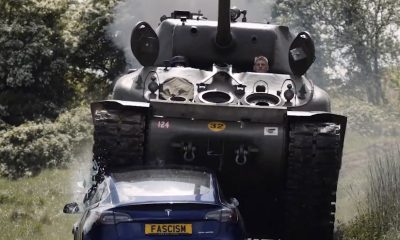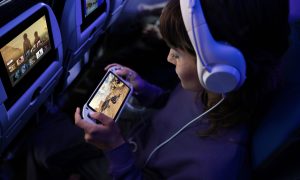

News
The Boring Company’s Vegas Loop Westgate station expected to open in the summer
The Boring Company’s (TBC) Vegas Loop Westgate station is expected to open in the summer, the Las Vegas Convention and Visitors Authority (LVCVA) told Teslarati.
The Westgate portion of the Vegas Loop is connected to The Boring Company’s Las Vegas Convention Center (LVCC) Loop. The LVCVA informed Teslarati that TBC is making progress on the Westgate tunnel.
Recently, TBC crews were sighted digging the tunnel between the Las Vegas Convention Center and Westgate. The new Vegas Loop tunnel begins at the northwest portion of the LVCC campus. The Vegas Loop station’s Westgate tunnel will surface at the Riviera station near the Convention Center’s West Hall parking lot.
“Tunneling is anticipated to be completed the second half of April, with the opening of the Westgate station expected sometime this summer,” the LVCVA shared with Teslarati.
The Vegas Loop at the Las Vegas Convention Center celebrated a significant milestone earlier this week: carrying its one-millionth passenger. The milestone is just the first of many—especially considering that the Vegas Loop is not fully operational yet.
The Vegas Loop is currently connected to the LVCC Loop via its tunnel to Resorts World. The Boring Company’s Resorts World station transports passengers to the Las Vegas Convention Center. Once at the Convention Center campus, passengers can easily travel between the West Hall to the South Hall with TBC’s LVCC Loop in approximately 2 minutes. Walking from the West Hall to the North and Central Halls typically takes 25 minutes.
The Vegas Loop is expected to build a 65-mile tunnel system from Downtown Las Vegas through Sin City’s resort corridor. The expansive tunneling system has 69 planned stations, noted the LVCVA, and it will end at the Harry Reid International Airport. The Vegas Loop is expected to transport up to 57,000 passengers per hour at full capacity.
The Teslarati team would appreciate hearing from you. If you have any tips, contact me at [email protected] or via Twitter @Writer_01001101.
News
Grok 3 by xAI Rolls Out on Azure AI Foundry with Free Trial
Grok 3 is now on Azure AI Foundry with a free preview until early June. From code to vision, Grok joins a growing roster of powerhouse models.

xAI’s Grok 3 model is now available on Microsoft’s Azure AI Foundry Models, launching with a free preview to drive AI innovation. The collaboration marks a significant step in making advanced AI accessible to developers worldwide.
Grok 3 became available on Microsoft’s Azure AI Foundry Models on May 19, 2025. Developers can explore xAI’s Grok 3 at no cost through early June. After the free trial period, Grok 3 prices will be as follows:

“Microsoft and xAI are thrilled to unveil the availability of Grok 3 into the Azure AI Foundry Models, marking a significant milestone in AI accessibility and innovation,” Microsoft stated in its announcement.
The partnership integrates xAI’s cutting-edge model with Azure’s secure, scalable infrastructure, enabling enterprise scenarios in reasoning, coding, and visual processing. Grok 3 is accessible via Azure AI Foundry’s catalog, alongside models from OpenAI, Meta, Cohere, NVIDIA, and Hugging Face, reflecting Microsoft’s commitment to a diverse AI ecosystem.
“The addition of xAI’s Grok 3 underscores Microsoft’s commitment to support an open, diverse AI ecosystem, rather than relying on a single model provider,” the company noted.
Like other AI models in Azure, developers can easily discover and deploy Grok 3’s model card. Grok 3 is also available for testing on GitHub models.
Microsoft provides two flexible deployment options for integrating xAI’s Grok 3 into applications: Standard Pay-Go or Provisioned Throughput Units (PTUs). The Standard Pay-Go option allows pay-per-token API calls for quick scaling. Meanwhile, the PTUs are better for reserved capacity with predictable latency.
“For production scenarios where you expect steady high volume or need strict latency, provisioning Grok 3 with PTUs can be cost-effective and reliable,” Microsoft advised.
The launch of Grok 3 on Azure AI Foundry empowers developers to build intelligent assistants, process large documents, or explore new AI applications. As xAI and Microsoft combine innovation with robust tools, Grok 3’s arrival signals a new era of AI development, inviting creators to leverage its capabilities and shape the future of technology.
Elon Musk
Tesla Robotaxi deemed a total failure by media — even though it hasn’t been released
Nearly two weeks before it is even set for its planned rollout, Tesla Robotaxi has already been deemed a failure — even though it is not even publicly released.

Tesla Robotaxi is among the biggest tech developments of the year, and its June launch date has not yet arrived.
This does not matter to skeptics of the company, as they have already deemed the rollout a “failure,” “an enormous mess,” and plenty of other adjectives. No matter what, several outlets are already leaning on biased opinions and a lack of true evidence that points in any direction.
Futurism posted an article this morning claiming that Robotaxi is “already an enormous mess,” citing the opinions of Dan O’Dowd, perhaps Full Self-Driving’s biggest critic. There is no mention of any of the excitement or prosperity that would come from the opposite side of the argument.
Instead, it included that O’Dowd felt it was a failure in an 80-minute drive around Santa Barbara.
This is fair to include: Full Self-Driving is not perfect, which is why Tesla will implement safeguards like teleoperation at first. However, it’s not like it’s so awful it isn’t even remotely close. Personally, my experience with FSD was incredibly successful, responsible, and it was something I still wish I had on my car to this day. I wish the article would have included a quote from someone who is as equally passionate about FSD, just from the other side of the argument.

Credit: Tesla
There is no mention of Tesla’s most recent Vehicle Safety Report, which showed Autopilot-enabled cars are nearly 10x less likely to be involved in an accident compared to the national average. This might not be the same as Full Self-Driving, but it is still a testament to what Tesla has achieved with its driver assistance systems.
To be fair, Tesla has been a company that has missed timelines, especially when it comes to FSD. I used to roll my eyes a bit when CEO Elon Musk would say, “We’ll have Full Self-Driving finished by the end of the year,” or “We’ll have a million robotaxis on the road next year.” I was always skeptical.
However, Tesla has handled things differently this year. They’ve admitted the Robotaxi rollout will be controlled at first, including a fleet of only 10-20 Model Y vehicles. It will be private at launch, and only the lucky invited will have the opportunity to experience it in Austin in June.
It might be less than a public rollout, which of course, for people like you and me, is disappointing. But let’s be real: if Tesla launched a full-blown Robotaxi platform with no regulations or small-batch testing, there would be criticism of that, too.
Some media outlets are pointing to the recent NHTSA request for more information on how Tesla’s tech will “assess the ability of Tesla’s system to react appropriately to reduced roadway visibility conditions.” This seems more than reasonable as Robotaxi will be among the first driverless ridesharing programs in the United States.
Tesla gets new information request from NHTSA on Robotaxi rollout
It’s no more than a request for information on how things will be handled and how the tech works.
It is sad to see so many outlets already deem something that could be the next big thing as a failure, despite there being no real indication of it being that or a success. Let’s be fair and give Tesla an opportunity to meet its June target and Robotaxi some time to operate and prove to be a reliable ride-share option.
News
Tesla confirms annoying Full Self-Driving feature has been fixed
Tesla has changed one of its driver monitoring features in a request from several owners.

Tesla has confirmed that an annoying Full Self-Driving feature has been fixed.
We reported last week that several owners reported changes in the feature, and now we have confirmation that it has been revised by Tesla.
Tesla Full Self-Driving (Supervised) does not require a driver’s hands to be on the steering wheel. However, eye movements and attentiveness are tracked through a cabin-facing camera, aiming to improve safety and limit loopholes in the system.
Tesla seems to have fixed one of Full Self-Driving’s most annoying features
If the system detects that your eyes are not on the road or you are not paying attention, FSD will nudge you to get them back on the road. Too many occurrences of the driver not paying attention will result in losing access to FSD for the remainder of the drive.
However, many drivers using FSD complained that the system was too quick to alert drivers of inattentiveness. Fixing things like the HVAC temperature or even Autopilot settings on the center touchscreen would get you a nudge, which seemed unreasonably fast. Many drivers said it was a seven-second limit, but it seemed faster than this.
🚨 This is really nice to hear. Tesla said they’d fix it! pic.twitter.com/lFIZGc6PQ5 https://t.co/JE4UFAWEZz
— TESLARATI (@Teslarati) May 15, 2025
In my experience, FSD nudged me to pay attention to the road when I was adjusting the speed offset, which gives the vehicle permission to travel over the speed limit by a percentage. For example, a 10% offset in a 50 MPH zone would let the car travel 55 MPH.
The nudging seemed to be too fast and annoying, and many other Tesla drivers agreed. CEO Elon Musk had even noted that the nudge was too fast and drivers were right to be annoyed with it, especially considering that, in theory, it would be safer to adjust these settings on FSD and not while operating the car manually.
Tesla took the criticism drivers had and turned it into a much-needed and notable change that has now been confirmed by Ashok Elluswamy, Head of AI and Autopilot for the company:
Was much needed
— Ashok Elluswamy (@aelluswamy) May 16, 2025
The change seems to be initiated on vehicles with Hardware 4. It is certainly a welcome change as the nudge was just a tad sensitive and could have been much more reasonable.
The adjustment made by Tesla came just a week after owners truly started becoming more vocal about the issue.
-

 News2 weeks ago
News2 weeks agoTesla Cybertruck Range Extender gets canceled
-

 Elon Musk4 days ago
Elon Musk4 days agoTesla seems to have fixed one of Full Self-Driving’s most annoying features
-

 Lifestyle2 weeks ago
Lifestyle2 weeks agoAnti-Elon Musk group crushes Tesla Model 3 with Sherman tank–with unexpected results
-

 News2 weeks ago
News2 weeks agoStarlink to launch on United Airlines planes by May 15
-

 News1 week ago
News1 week agoTesla Semi gets new adoptee in latest sighting
-

 News2 weeks ago
News2 weeks agoTesla releases paid performance upgrade for new Model Y
-

 News2 weeks ago
News2 weeks agoTesla launches its most inexpensive trim of new Model Y
-

 News2 weeks ago
News2 weeks agoNew Tesla Model Y proves very sturdy after shocking high-speed crash




















